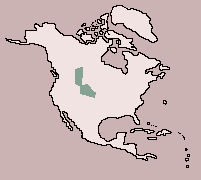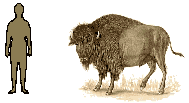Bison

| Class: Mammalia:
Mammals |
Diet: Grass |
| Order:
Artiodactyla: Even-toed Ungulates |
| Size: body:2.1
- 3.5 m (6 3/4 - 11 1/2 ft), tail: 50 - 60 cm (19 3/4 - 23 1/2 in) |
| Family: Bovidae:
Bovids |
Conservation Status: Near Threatened |
| Scientific Name:
Bison bison |
Habitat: prairie,
open woodland |
| Range:
N. America |
 Although
there were once millions of bison roaming the North American grasslands,
wholesale slaughter by the early European settlers brought them almost
to extinction by the beginning of the twentieth century. Since then, due
largely to the efforts of the American Bison Society, herds have steadily
been built up in reserves, where they live in a semiwild state, and it
is estimated that there are now some 20,000 animals. Although
there were once millions of bison roaming the North American grasslands,
wholesale slaughter by the early European settlers brought them almost
to extinction by the beginning of the twentieth century. Since then, due
largely to the efforts of the American Bison Society, herds have steadily
been built up in reserves, where they live in a semiwild state, and it
is estimated that there are now some 20,000 animals.
 The
male may be as much as 2.9 m (9 1/2 ft) at the shoulders, which are humped
and covered with the shaggy, brownish-black fur that also grows thickly
on the head, neck and forelegs. The female looks similar to the male
but is smaller; young are more reddish-brown. Both sexes have short, sharp
horns. Primarily grazers, bison live in herds that vary from a family group
to several thousand; huge numbers formerly made seasonal migrations in
search of better pasture. They feed morning and evening. During the day,
they rest, chewing the cud or wallowing in mud or dust to rid themselves
of parasites. During the mating season, bulls (males) fight for cows (females),
which give birth to a single calf, away from the herd, after a gestation
of 9 months. Within an hour or two, mother and calf rejoin the herd. The
calf is suckled for about a year and remains with its mother until it reaches
sexual maturity at about 3 years old. The
male may be as much as 2.9 m (9 1/2 ft) at the shoulders, which are humped
and covered with the shaggy, brownish-black fur that also grows thickly
on the head, neck and forelegs. The female looks similar to the male
but is smaller; young are more reddish-brown. Both sexes have short, sharp
horns. Primarily grazers, bison live in herds that vary from a family group
to several thousand; huge numbers formerly made seasonal migrations in
search of better pasture. They feed morning and evening. During the day,
they rest, chewing the cud or wallowing in mud or dust to rid themselves
of parasites. During the mating season, bulls (males) fight for cows (females),
which give birth to a single calf, away from the herd, after a gestation
of 9 months. Within an hour or two, mother and calf rejoin the herd. The
calf is suckled for about a year and remains with its mother until it reaches
sexual maturity at about 3 years old.
  
|

